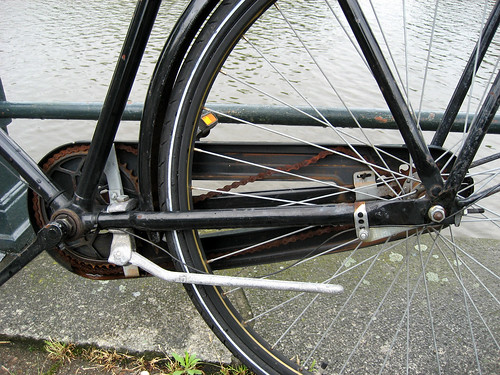How to buy a used bike

(As usual, I may have missed some points. Feel free to add them in comments....Ed)
More people are turning to bicycles for basic transportation every day. New machines aren't necessary for commuting or utility transportation. A serviceable used bike will do nicely.
Today, I want to talk about buying a used bike. One topic I will not cover in this post is proper bike fit, but I'll say right up front that fit is a key aspect to long-term comfort. A bike that is too large or too small will cause pain and may be dangerous. I am not well qualified to assist with bike fitting, though there are websites that can help. Be aware that like so many other aspects of cycling, the subject of fit does not meet with universal agreement.
http://www.peterwhitecycles.com/fitting.htm
http://www.coloradocyclist.com/bikefit
http://www.cyclemetrics.com/Pages/FitLinks/bike_fit_links.htm
Another topic that I'll avoid in this post is the quandary faced by collectors versus users. Yes, some rare bikes turn up now and then at garage sales and flea markets, bikes that collectors would love to have. People like me, however, buy bikes to use and use hard.
Where to buy a used bike
A bike shop is an obvious choice when looking for a used bike. Most shops will take a bike in trade provided it's in good condition, and then re-sell it. They won't take abused, damaged, or high-mileage bikes because the costs of refurbishing them are too high. Bike shops will most likely have the highest prices for used bikes, but then again, the bikes will be serviceable and properly maintained.
Further down the food chain are used bikes available from yard sales or friends and neighbors. Yard sales can be good sources provided you know how to evaluate a used bike. Friends, neighbors, or relatives often will be happy to get rid of an old bike especially if they see that it will be put back into service.
Flea markets and pawn shops are more problematic. The bikes for sale will have had no maintenance. They may be stolen. Unless you are very knowledgeable, avoid them.
E-bay and Craigslist are popular bicycle sales venues, too. Again, be wary.
Finally there's that guy who has a deal that's just too good to be true – a carbon fiber bike with top end components at a bargain basement price. I'll say it again, slowly this time, S-T-O-L-E-N. Don't buy from bike thieves. It's bad karma because the bike you get will be more like a rental.
What are your mechanical skills?
This has some bearing on used bikes because a good mechanic with an overflowing junk box can get a bike rolling again with minimum expense. But if you have few mechanical skills and have to depend on a shop for maintenance and repairs, a used bike can quickly become a money pit. Even for an experienced mechanic, an old frame with extensive corrosion and a fully rusted chain and freewheel, bent wheels, and rotted tires is not going to be worth the time and money to repair.
What to look for?
What's your first impression of the bike? If it looks like it was left outside in the weather, with faded paint, rusty chrome, dry-rotted tires, and significant corrosion on the chain and cables, it may be too costly to return to serviceable condition. As a general rule, any used bike more than a few years old will need new tires right away. But if the bike appears more dusty than rusty, it may be worth further investigation.
The first thing to do is an ABC Quick check. A is for air. Are the tires pumped up or are they flat? If you add air, do they go flat again in seconds? Do they show any dry rot? B is for brakes. Test the brakes by squeezing the levers. You should be able to insert a finger between the brake lever and handle bar when the brakes are fully applied. If the lever hits the bar, the cable needs to be adjusted. Does the lever release fully or does it stick? If it sticks, the cables may be corroded or frayed. Is the chain installed on the chainrings? If it's not rusted, lift the bike and turn the crank gently. You may have to move the shift levers slightly to 'tune out' any noises. Does it run smoothly? Stop the back wheel and turn the crank backward – gently – and listen for any noises. See that the chain stays on the chainrings and doesn't bind in the rear derailleur. If it falls off, the chainring may be bent. Sight down along it as it turns to look for any wobbles. Likewise, if the chain binds in the rear derailleur, the derailleur hanger or the derailleur itself may be bent. This also reveals stiff links as they 'pop' when they go through the jockey wheels. If the bike is equipped with quick release wheels, see that the cam action on the quick release skewers actually works and that the levers haven't simply been turned to hold the wheel in place.
Allow me to give you a warning about compatibility and parts interchangeability on old bikes. Back in the 1970's bike boom, most bicycles were equipped with components from their country of origin. So French bikes had French parts. Italian bikes had Italian parts, etc. There was no extensive part interchangeability. They used different diameter handlebars, stems, and seat posts. Parts were not threaded the same, so for instance, Italian pedals could not go onto a French bike. I warn you about this because there are many of these old bikes still available, and parts availability for the old French bikes in particular can be difficult.
The expensive stuff.
Let's start with the heart of any bicycle, the frame and fork. Sight from the side. Do the fork blades line up with the head tube or do they look bent back? If they appear to be bent back, the bike was probably in a collision. Look under the top and down tubes. If you see small bulges just behind the head tube on the bottom of the top and down tubes, the bike was definitely in a collision. Are there any pinholes or bubbles under the paint around the bottom bracket or along the chainstays? They indicate internal corrosion. Are there any cracks around the bottom bracket shell or any of the lugs? They indicate imminent failure. Sight from the front. Does the fork appear to be bent to either side? Do the blades show any cracks? Look at the rear dropouts (frame ends). Do they show any cracks? Are they straight? Cracks or bulges anywhere on a frame are cause for concern. Do not buy a used bike if it has these defects.
Most bikes will be equipped with 700c, 27 inch, or 26 inch wheels and tires. Old bike boom machines may have 27 inch wheels, and while they can be perfectly serviceable, tire selection may be limited. Avoid any with steel rims because their braking action is inferior to an aluminum rim. Steel rims are still found on cheap discount store bikes. Be aware that if you replace 27 inch road wheels with the current standard 700c units, the brakes pads may not extend far enough to engage properly.
Spin the wheels. Look for any out-of-true condition. The wheel shouldn't move side-to-side or up-and-down. Likewise, the tire shouldn't have any bulges or cuts. With the wheel stationary and the bike sitting on the floor, try to move each wheel side to side, feeling for any looseness in the hub bearings. Squeeze the spokes two at a time, looking for any individual spokes that seem too loose or too tight.
The quickest way to evaluate the drivetrain condition is with a chain wear gauge. A worn chain rides up higher on the chainring and cog teeth, accelerating wear on them as well. Without a gauge, you can measure the distance between the centers of twelve links. A new chain will measure 12 inches exactly. A worn out one will measure 12 1/8 inches. Chain, chanrings, and cogs wear together, so problems may not be apparent until one of them is replaced. Often only one or two cogs will be worn on a cassette. When they're under pressure, as in climbing a hill, they may make clunking or snapping noises.
Other, hopefully cheaper components.
Shift the chain onto a center cog. Sight from behind to see that the derailleur cage is aligned with the cog. The pulleys should be in the same plane as the cog, not pushed in or twisted relative to it. See that the front derailleur moves freely through its range.
Look at the fasteners for any that are stripped or missing. Stripped Allen head bolts will be rounded rather than hexagonal.
Look at the cables. A new one is shiny and bright. An old one is dull gray. One that's been out in the weather is dark gray and may show some whitish corrosion from dissimilar metals or worn out lubricants. If a cable sticks in its housing, replace it.
With the bike on the floor, apply the front brake and try to move the bike fore-and-aft. Any looseness will come from the headset or a loose front brake. Test the rear brake the same way. Any looseness comes from the brake mounting bolt or the individual brake arms.
Grab one crank arm and try to move it side to side. Any looseness comes from the bottom bracket assembly. Rotate the cranks and watch for bent pedals. A bent one will seem to change its angle relative to the crank arm as it rotates.
Stand behind the bike and look carefully at the saddle and seat post. A cracked or sagging saddle may be evidence of a bad fall, especially if its rails are bent. Inspect the seatpost binder bolt carefully. It should not be bottomed out, that is, the slot in the frame should not be completely closed when the bolt is tightened. If it can't be fully tightened, the seat post may be a replacement of the wrong diameter. Try to move the saddle side to side to test this.
Stand in front of the bike and look carefully at the handlebar. It should not appear to sag on either side of the stem, and should appear to be level when the bike frame is vertical. A sag on either or both sides of the handlebar indicates a fall and a weakened bar. One that appears to be straight, but is canted relative to the frame indicates a twisted stem. Sometimes there may be internal damage to the steerer tube as well. Be prepared to replace these parts immediately as they can break without further warning.
Accessories
Some used bikes will come with accessories like water bottle cages, frame pumps, racks, or even lights and fenders. See that their mounting screws are present and not stripped. Look for broken water bottle cages as they are fairly common. Before trusting a rack, see that the mounts are tight and nothing is bent or cracked. See that all this stuff works before you use it for commuting, because Murphy's Law is inescapable. What can break or fail will do so at the most inopportune time, and chances are it will be both dark and raining.
Labels: bicycling education



1 Comments:
I've read several similar posts and yours is the most helpful so far. I'm not a mechanical wiz but I appreciate the specific recommendations for mechanical evaluation. Thanks.
Post a Comment
<< Home